China Eastern is not an airline I ever really expected to fly. With a fleet of new Boeing 777-300ERs, the opening of a new route to Chicago, and a small investment from Delta Air Lines, China Eastern is modernizing and becoming a real player in the North American market. When I saw a fare posted of $650 round-trip between New York and Japan, I jumped at the opportunity to give this airline a try.
My routing was New York JFK to Osaka, Japan via Shanghai, returning from Tokyo Narita back to New York. On the first leg to Shanghai, China Eastern graciously upgraded me to business class in order to experience the new product.
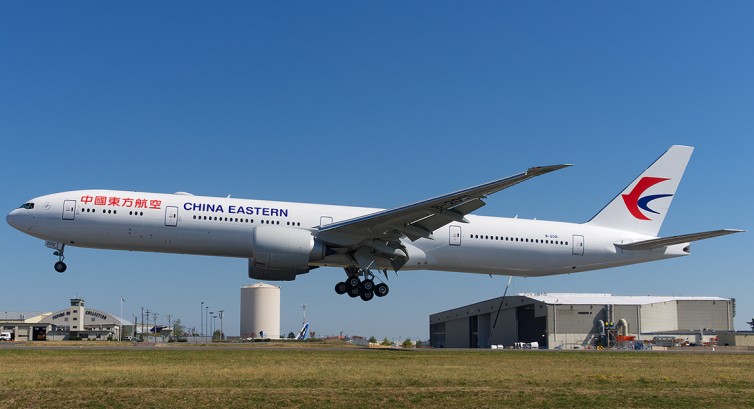
A Boeing 777-300ER at Paine Field showing China Eastern’s new livery- Photo: Bernie Leighton
At JFK, China Eastern departs from Terminal 1 and uses the recently renovated Air France lounge. Although this flight departed at 2:00 am (thanks for nothing, daylight saving time), the lounge was actually surprisingly crowded. As boarding time neared, I headed to the gate to find utter chaos. Lines of passengers extended in every direction with no signage to tell anyone where to stand. Eventually, gate agents put up a few signs, but that should have been done much earlier. A hectic boarding process sets a negative tone for a 15-hour flight. The same hectic process was applied to all four of my flights, indicating that China Eastern has a systemic problem with orderly boarding.
Boarding through the forward door of the aircraft took me through the first class cabin on my way to business. That’s right, China Eastern operates a true three-class aircraft, complete with suite-style first class seats, the middle of which combine into a large bed if booked together. Unfortunately, there is no premium economy cabin, or even an extra legroom economy section.
BONUS: Flying on the American Airlines Boeing 777-300ER in Business Class
The business class cabin is configured in a 1-2-1 reverse herringbone layout, which is one of the nicest hard products offered today. It is the same seat offered by American Airlines on its 777-300ER, and is licensed from Cathay Pacific who uses it extensively on their fleet. Each seat is outfitted with Panasonic’s latest eX3 entertainment system, power and USB outlets, and ample storage space. The fully-flat seat is roomy, comfortable, and provides one of the best experiences flying today. I could not ask for much more out of a business class seat.
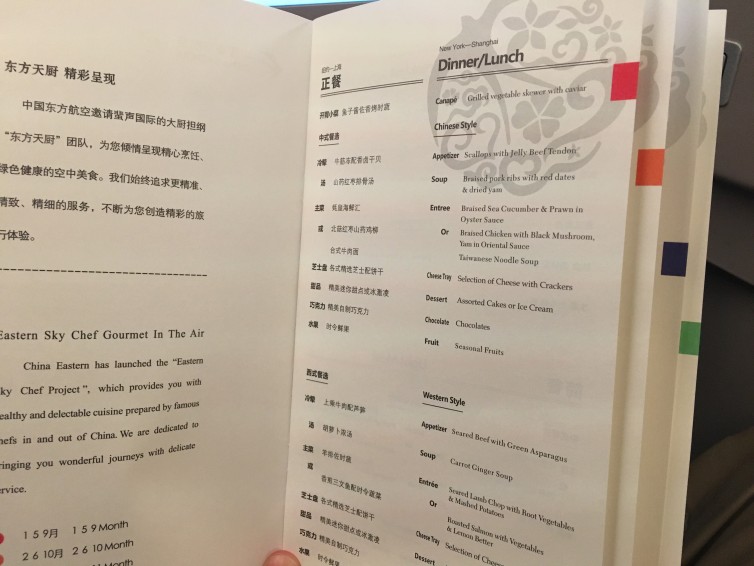
The different colored tabs correspond to different sets of months. This approach to printing menus just screams “cheap operation” to me. – Photo: Jason Rabinowitz
As I settled into my seat, a flight attendant came by to introduce herself and handed me the service menu. She instructed me to turn to page five, which confused me for a moment. Only then did I realize that China Eastern prepares one menu for the entire year, and has certain months correspond to particular pages of the menu. Since these menus are obviously reprinted throughout the year as they get worn, this tactic makes absolutely no sense to me. No premium airline I have ever flown does this, presumably to save a few cents on printing costs. This was just the first on-board clue of how China Eastern is evolving, but is still a bit rough around the edges.
The meal I ordered off the printed menu was actually quite good. I opted for the seared duck breast with orange glaze after being told my first choice of sliced car siew wanton noodle soup was unavailable. The meal was nicely presented and served at a good pace for this extra long flight. I would have preferred an a la carte-style meal service, as I really was not interested in dinner after a 2:00 am departure, but wanted to make sure I was not left without a meal later into the flight.
One of the staples of a business class experience is the amenity kit. The kit itself serves as a reusable reminder of the airline experience, packed with essential items to stay fresh during the long journey. Although China Eastern provides an amenity kit to premium cabin passengers, the contents were a bit anemic. The Clarins-branded kit (not China Eastern-branded) contained only lip balm, hand cream, ear plugs, and a toothbrush with toothpaste. The execution was there, but once again it just seemed to lack real forethought. Pajamas also would have been nice, as it has become a rising trend among premium airlines on long-haul routes.
The entertainment system is a critical component of the 15-hour experience. While the eX3 entertainment system is of the latest generation from Panasonic, it too felt incomplete and not ready for prime time use. The graphical user interface was bare bones and uninspired, but functional. While most airlines have enabled picture-in-picture features, live TV, and other differentiating features, China Eastern opted for the most basic of menus. The movie selection was deep enough to keep me entertained, but the catalog was confusing and hid many selections under odd categories. The headphones supplied in business class were cheap and inexcusably poor for a 15-hour flight — I would expect this quality more in economy, not business class. Thankfully, I remembered to bring my own. Again, the thought was there, but the execution was poor.
Frustratingly, every time the PA system was utilized, the system would boot everyone back to the main menu. If I was watching a movie, I had to sift through the menu system to find that movie again, and then seek to the point at which it had been interrupted. It shouldn’t be this way in 2016.
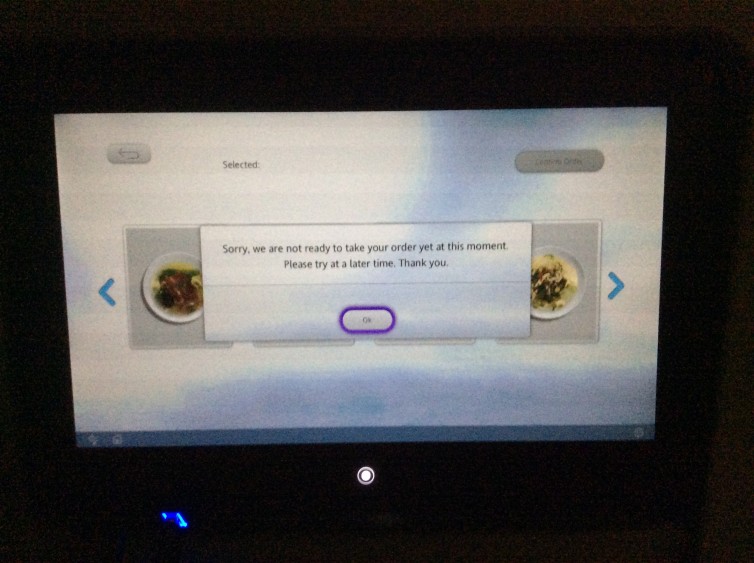
The entertainment system listed some very delicious looking dishes, which I assumed were available as snacks. I was wrong. – Photo: Jason Rabinowitz
The entertainment system also offered on-screen meal and drink ordering, or at least I thought it did. The menu system listed endless delicious looking meals and drinks that I had assumed could be ordered throughout the flight as a snack. I was wrong. When I actually tried to order anything, an error occurred telling me the service was not yet offered. If that is the case, it should not be presented front and center in the menu system. Disappointing.
China Eastern is one of the first airlines based in China to offer in-flight WiFi, which is ’œavailable’ on all 777-300ERs and select A330s. I put the word available in quotes because unless you really, really know what you are doing, you can not actually use it. China has very strict internet use rules. They must know exactly who is using it, and even then a multitude of services, such as anything Google related, are blocked.
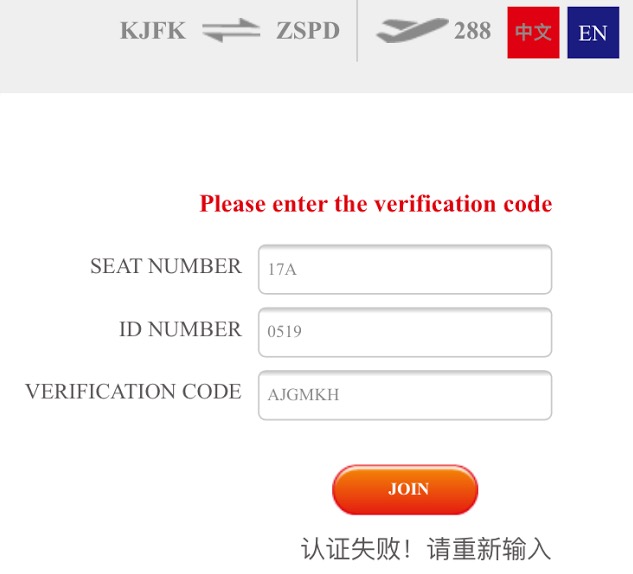
After going through the painful process of pre-registering for Wi-Fi, all I got on the flight was this error page for 15 hours
If you are just learning that your flight offers WiFi at the airport or once you are on board, it is too late for you to sign up. That is right, you actually have to be authorized ahead of time in order to use the internet on board. The process is convoluted, difficult, and time consuming. There is a link on the North American English page on how to apply for in-flight WiFi access, but it just directs you to the Chinese site. Once there, you have to navigate to the ’œair network’ registration page, and then switch to the English version if you can find it. Here, you must simply enter your ticket number and name. Oh, but this only works if you are a member of China Eastern’s frequent flyer program, which took me multiple days to sign up for. Unsurprisingly, registering for that program is a hassle and struggle partially in English and partially in Chinese. You really, really need to want WiFi to go through all of this.
I actually got the WiFi to work on the return flight. On the flight out of JFK, the pilots fat-fingered the flight number in the Flight Management System and the iron-clad WiFi authentication portal could not verify my pre-registered information. It is amazing how much of the internet I use on a daily basis does not work on Chinese ‘net. Although I had access, I really could not do much with it. No Google-powered email, no Twitter, no Facebook, no western news. Because Twitter was blocked, I utilized Weibo (a Chinese site akin to a Twitter and Facebook hybrid) to share my flight in real-time. The plan worked, but a little better than expected.
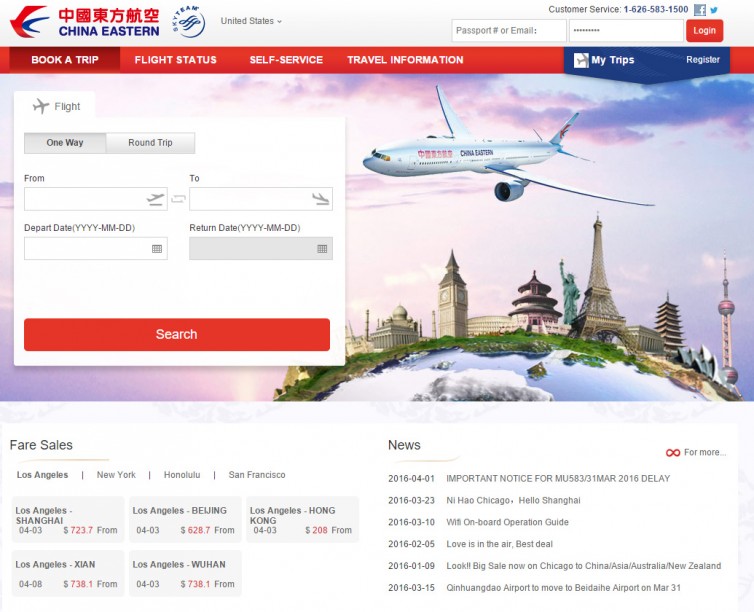
The China Eastern U.S. website – Image: us.ceair.com
The WiFi issues and registration process brings me to the next weak point in the experience. China Eastern’s North American and English sites are a wreck. They provide bare bones functionality and nothing more. Imagine the website of an American airline from 1996 and you have China Eastern’s site in 2016. You can purchase a ticket, validate your ticket, and check flight status, but that is about it. Forget about seat assignments, ticket changes, or anything else. China Eastern’s mobile app is also only available in Chinese. This really needs to be updated for an airline looking to establish itself as a real player in North America.
On the return from from Shanghai to New York, I flew in economy in row 70. The economy cabin of China Eastern’s 777-300ER is pretty standard. Seats are arranged in the now-typical 3-4-3 high density configuration, but with a roomy 32’ pitch. Each seat has on-demand entertainment, a USB port, and shared power outlets under the seats. This is pretty much the best you can hope for in economy these days.
On China Eastern’s 777-300ER, row 70 is way in the back, where the rows narrow down from 3-4-3 to 2-4-2. I thought I would be sitting pretty in the side section with only 2 seats instead of 3. I was wrong. My seatmate was broad shouldered, and tended to lean in my direction, violating my already limited personal space. This made the already ~17’ seat width seem that much narrower.
The seatback entertainment screen was of a generous size for an economy seat, but had the same half-baked interface as the business class seat. There was one additional problem that was magnified in the back of the plane, however. Just like in business class, every time the PA was used, the screens all went to the main menu, even if they were initially turned off. But they also went to full brightness, which in a dark cabin on an overnight flight is horribly rude. Thankfully, the cabin crew was aware of this issue, and each time they went around the cabin turning off screens that had come back to life on their own. Bravo to the crew, and a big “what the hell were you thinking!?” to whomever approved the user interface on the otherwise fantastic Panasonic sysyem.
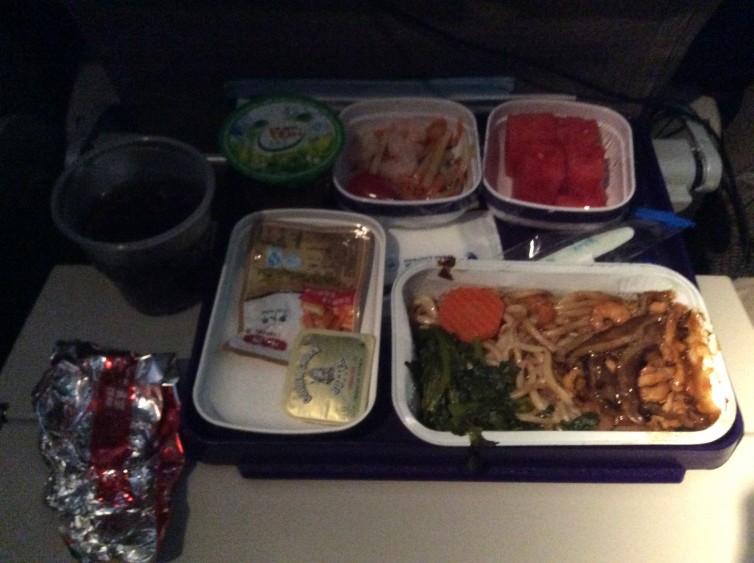
Sorry for the low resolution meal shot. Chinese law forbids the use of cell phones on board, so I had to use my inferior iPad camera – Photo: Jason Rabinowitz
The meal served in Economy was decent enough, but there was a minor problem that the crew warned me about. At cruising altitude, aircraft fly with about a 3° nose-up attitude. Because of this, tray tables need to be slightly angled to account for the tilt, or else everything will just slide right off. Towards the rear of the economy cabin, the tray tables were not properly angled, and trays of food would slide right off. This made eating meals exceptionally difficult.
%CODE1%
I Weibo’d (?) a picture of my meal (which was decent) and my experience with the tilted tray table so that it would send to Twitter. What I did not know was that somehow, although I had zero followers there, my posts had gathered some attention in China. It seems that very few people, if any, had ever live-shared a China Eastern flight before, and the airline did not quite know how to react to it. About halfway into the flight, one of the flight attendants walked up to me and asked to speak in the rear galley. Strange, very strange.
It turned out that in one of the pictures, the dishes on my meal tray were not in the order in which they are supposed to be served. Of course, this was because I had moved them around to prevent them from falling into my lap due to the faulty tray table. Someone at China Eastern, however, assumed the crew had improperly served the meal. They actually sent an ACARS message to the flight deck and had it relayed to the flight attendants, giving the impression that they provided me with bad service — which could not have been further from the truth. The crew wanted to ensure that I was satisfied with their service. The flight attendants were the one positive constant throughout this experience. They were attentive, caring, and helpful. The issue here was with the tray tables being improperly engineered, not the flight crew’s level of service. Although weird and wrong, at least the airline was making an effort to engage with issues live. Something that I support, but again, still a bit rough around the edges.
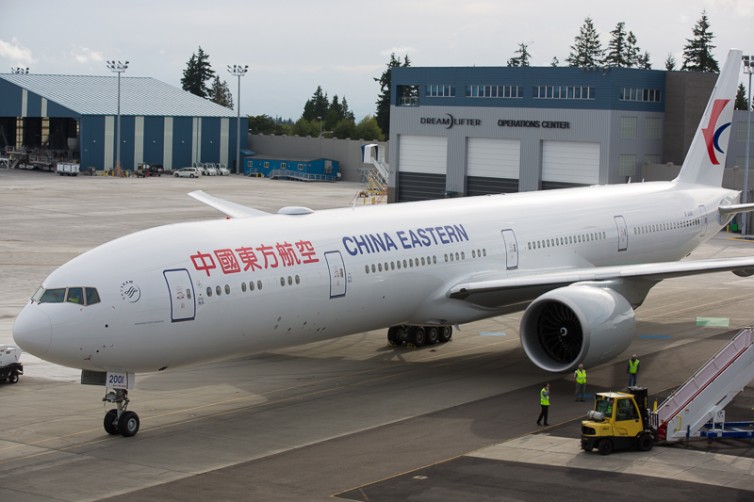
China Eastern’s first Boeing 777-300ER seen next to the Future of Flight – Photo: Jeremy Dwyer-Lindgren
When it all boils down, the aircraft itself is world-class. The business class seats best the offering of many major airlines, and the economy class cabin offers plenty of legroom and amenities. The soft product – from boarding, to amenity kit, to meal menu, to half-baked entertainment system – distracts from it all. What should be an exceptional experience gets diluted down to an average experience due to the not-quite-finished nature of the core aspects. Thankfully, these are all things that can be fixed with minimal effort and a bit of time. With the added investment and guidance from Delta, there is no reason why China Eastern should not be able to become a top-notch, top-tier airline.
Note: Although I paid the base economy fare, the one-leg upgrade was complimentary, but my views and opinions are my own.
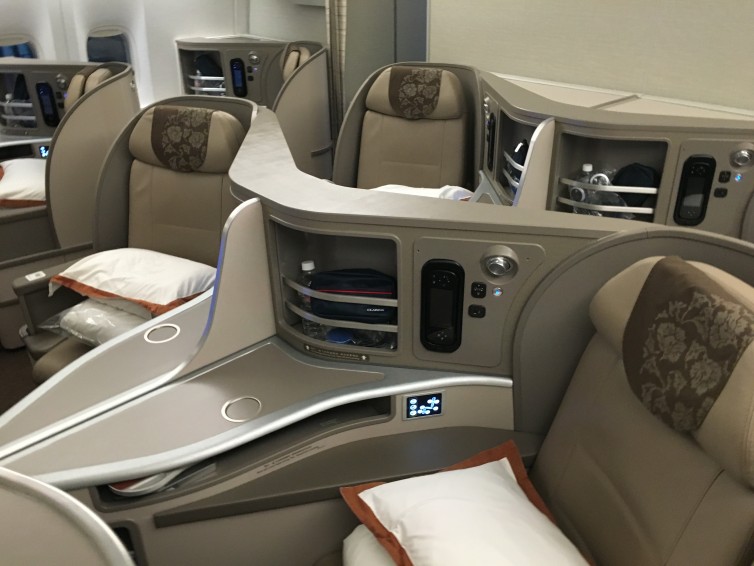
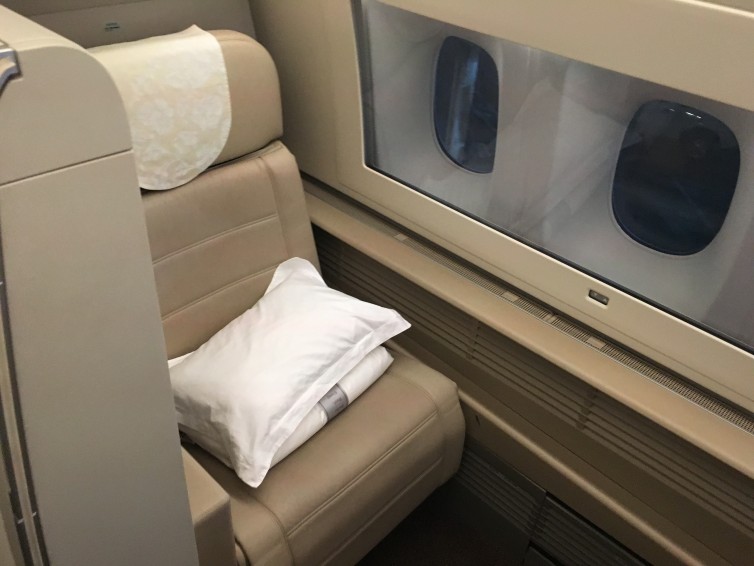
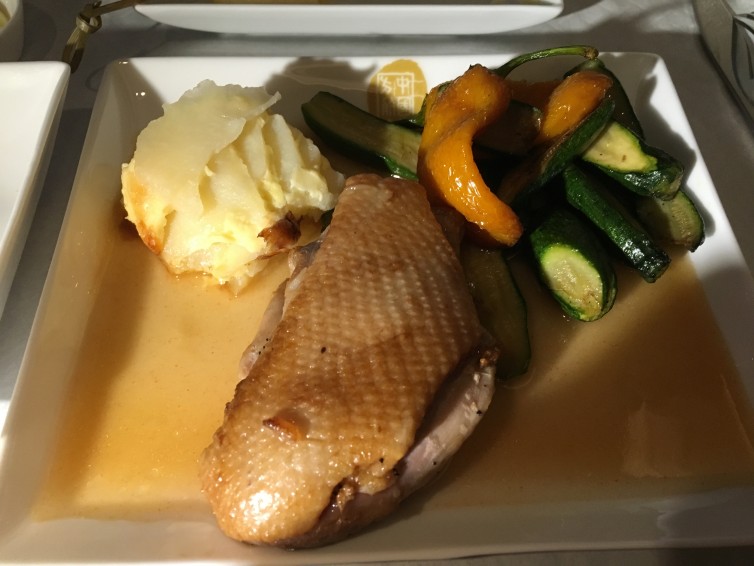
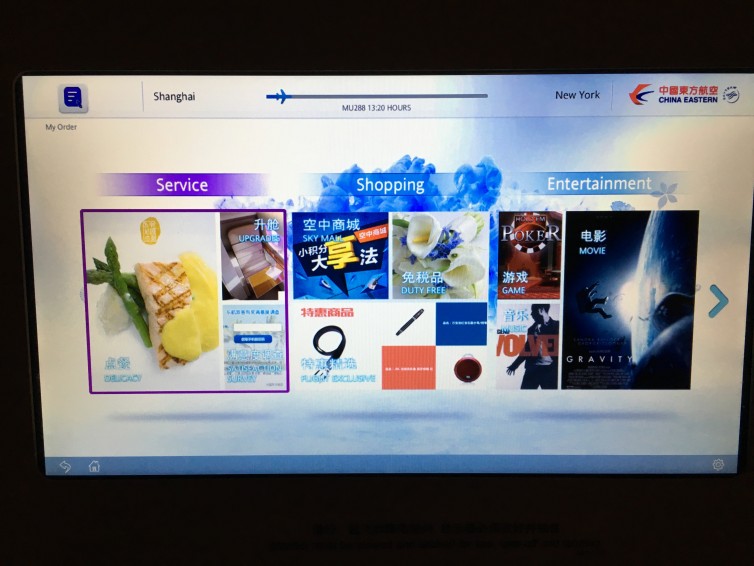
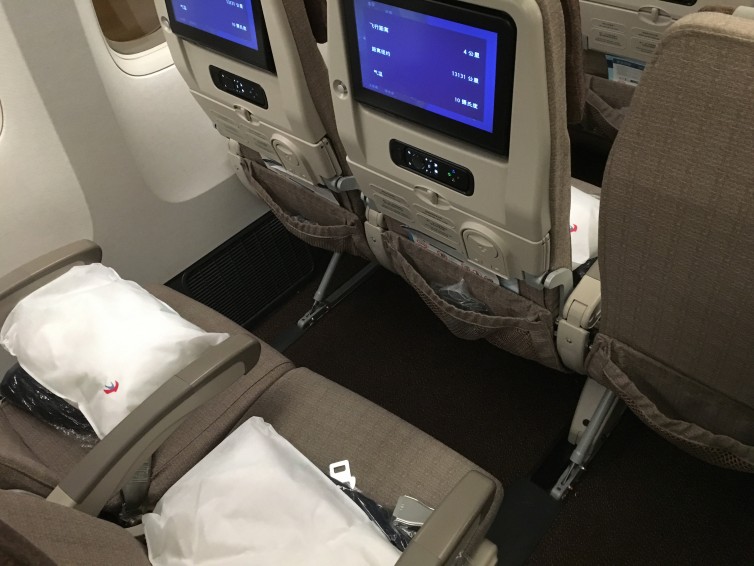
There is though, there are so many reasons that China Eastern simply will not bother to take Delta’s advice. Even then, Delta is not top-tier.
Let’s edit your sentence “With the added investment and guidance from Delta, there is no reason why China Eastern should not be able to become a consistently decent airline.”
Because that’s what Delta is. Yes, from a Pax-ex perspective they are doing a lot- but big means inconsistency. Big means bizarre policies to annoy the frequent flyers. Big means throwing your weight around to get what you want. I admire Delta for their ability to be consistently neither under, nor over, whelming. I do, but if that is what the industry has come to aspire for- we are all doomed. Why yes, on a 2:45 flight, I would certainly kill for no hot meal in paid “F”! Now that’s a choice!
Now to explain why MU will never aspire to greatness beyond box-ticking. 3.55% is an investment for the sake of either investing or making a statement to the Chinese Government that you are serious about China. 3.55% is not enough to say “Hey! Fix the soft product issues! Especially when many of them are not entirely unique to MU.” It may fix the PA system booting you back to mainscreen every announcement 3.55% of the time – I don’t know. It will not fix the bizarre identity verification required to use the Chinese internet anywhere. A lot of the problems fall back to government policy. Crazy internet nonsense, massive government ownership, fleet decisions and route decisions made to block future competition. Delta can fix exactly none of those. Even if Delta was the best airline in the World , they couldn’t get past the fact that a. they are outsiders, and b. they are not affiliated at all with the Party. Now, if DL had bought a larger stake in HNA- I’d agree with you… half-heartedly, because again, really dude? DELTA? TOP-TIER?
It felt like MU was trying to pivot with the purchase of this aircraft. Just look at it. I would kill for a 77W like that on many of the routes I fly very frequently. Put an ROC numeric B-rego on it and toss it cross the straights and I bet your flight would have been epic! The thing is that MU does not have to even come close to making a profit, and it shows. Spend an absolute ton of money on making a truly amazing looking 77W- but cheap out on the experience. They wanted to market the seats as a differentiator against their competitors within the mainland. Truthfully, that’s a huge differentiator within the Chicken. That’s probably why they never considered matching western expectations of soft and hard products being equal. Now, regarding the amenity kits; a lot of “top-tier” which I now must say in quotes due to its apparent recalibration hand out nothing in terms of amenity kits or “washbags” with even less included.
You can buy the best seat in the world, but you can still be outrightly terrible in every other way. Reminds me a bit of AA, there. 3.55% of an airline cannot cause a cultural shift, and the reason mainland Chinese Airlines are so unpolished with dim chances at greatness is because of the corporate culture.
Agree with each. and. every. word.
I’ll expand on this and add that none of the Chinese-3 will respond simply with the presence of foreign cash. Keep in mind China is almost strictly a bottom-line nation – money in, money out. Foreign money is there solely to make more money. Usually for China. Quantity well over quality.
Now, I can see MU or CA or CZ retaining a Western “product specialist”, but don’t count on that being more than window dressing for the sake of “product differentiation”. Unless/until, say, a nut-rage-esque incident involving a highly-ranked member of the Politiburo, perhaps?
(Notice I’m not naming names. It could be money from any first-world airline from anywhere, it really matters not.)
Also, if you thought MU’s website is “a wreck”, I suggest not even touching Xiamen, Spring, or any of the other second- or third-tier mainland airlines. I’m sure you’re stressed enough as it is.
Please don’t take this the wrong way Jason, I really enjoyed reading your review and appreciate you posting it. Just don’t get your hopes up for the wrong reasons.
Many thanks for this timely review. I’m flying MU JFK-PVG-SIN business in May. I know what to expect t! Thanks again
I enjoyed your review Jason very much, quite interesting and please don’t take this the wrong way, pretty comical. Just a China Eastern surprise around every corner. Here’s to better flying!
Gene
I’m based in Shanghai and flew the MU 777-300 a couple of times in biz class LAX to PVG. This review is spot on. Seat is great and everything else leaves you wishing for a bit more. That said, the red-eye option from USA to China (i.e. take off from USA past midnight and arrive in China shortly after dawn the following day) makes it my preferred route returning to China. I “lose” one less day flying from USA to China and can generally sleep well with that nice seat and not many other distractions. And getting Delta miles seals the deal. Thanks Jason for your review!
Last time I flew the MU A330 from CDG to PVG the experience was pretty similar. 1-2-1 reverse herringbone seating with nice seat and limited entertainment options with cheap headset. But the afternoon departure and early morning arrival was just right timing and could get a good sleep.
I’m pleasantly surprised that you speak so highly of the cabin crew, so I hope their ground-based supervisors were persuaded and that the FAs didn’t get into trouble over the pic, and in fact should be lauded.
After seeing some of the products being offered at WTCE by Chinese companies, I wouldn’t be surprised if MU had a lowest-cost procurement policy and stuff like the headphones were the result.
Thanks for the look into the MU experience… so that I didn’t have to do it myself 🙂
I’d be leery of flying on an Asian airline, I don’t care how great the price or airplane is. Its the guys up front can either get you from point A to point B or not get you from point A to point B. Unless things have changed in the past several years, their crew resource management (CRM) approach to flying leaves a lot to be desired. As most folks know, cultures vary from one part of the world to another. American pilots for example will voice their opposition to what the other pilot might be doing, even if it involves a threatening tone. They will not just sit there while the other pilot intends on doing something stupid. In fact,as a captain, I have taken the control of an airplane away from several individuals in the past who were not doing what I thought they should have been doing. I’ve also informed captains as a first officer that they really needed to do something different and they actually took me up on my unsolicited advice!! Not so in the Asian culture. The captain is on practically on par with God himself. A first officer dare not question his flying. And now you have the Islamic factor thrown in. Not a real good recipe for success. As of about 5 years ago the above culture still prevailed through many parts of Asia.
“Asian airline” – that is a very broad church. One doubts that the CRM culture at Singapore or Cathay could really be lumped in with, say, Korean. As for the Gulf carriers – many (if not most) of the techies at all three are gringos, so perhaps the readers would be interested to understand where “the Islamic factor” comes in. I do’t think it’s impossible to find western pilots with a bit of a god complex.
Flew biz JFK-PVG-SIN 2 weeks ago. 777-300 from JFK: no problems boarding, quite civilized, seat was roomy but I found it very hard for sitting, lie flat was no problem since I prefer it firm, slept a good 8 hours, food portions were very tiny, mid flight snack was a small toast with small piece of smoked salmon. It was a Delta award ticket, would fly again only if the price was right.
Oh man, flying back economy pvg to jfk must have been torture. After hearing China Eastern is so rough around the edges Cathay Pacific business is the only transpacific option I would consider.
Jeff I’m glad you have the money to afford Cathay. In the real world us peasants have to work hard just to ride Xiamen J class. But I”m guessing your company is probably paying your fare anyways.
I flew both china eastern 777 and Cathay 777 to Phillipines in 2015 and again in 2016. Both were decent experiences but Cathay was better overall as i like the 9 abreast in coach versus 10 in China eastern. .nothing like the dc 10s and l 1011s from back in the 80s but the fact that meals are included is a plus.